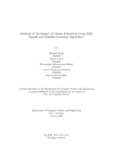Analysis of the impact of online education using EEG signals and machine learning algorithms
Date
2021-01Publisher
Brac UniversityAuthor
Hoque, EhsanulAhmed, Tausif
Shabab, Mohammad Adituzzaman
Bakhtier, Tahsin Mohammad
Abdullah, Sayeem Md
Metadata
Show full item recordAbstract
Online learning has allowed students from different walks of life to access a vast
amount of information, allowing them to gain new skills. However, only having
access to that information does not mean that the students will comprehend it.
In this report, we study the impact of online education on students, specifically
their confusion levels. The dataset that we have used in this report was taken from
Kaggle. The dataset consists of mostly preprocessed Electroencephalogram (EEG)
brain wave values i.e., Attention, Mediation, Raw, Delta, Theta, Alpha, Beta, and
Gamma. Due to the limitations of the dataset, the accuracies of the Machine Learning models when only using EEG signal values were not satisfactory. Therefore, later
into our research, we have decided to modify our dataset in order to better determine the confusion level of students. We have synthesized the dataset taken from
Kaggle to form another dataset, where we took the content being viewed into account which led to better classification. The Machine Learning Algorithms that we
have implemented in this paper are Decision Tree, Random Forest, Bagging with
Random Forest, Gaussian Naive Bayes, K-Nearest Neighbors, Gradient Boosting,
XGBoost, and Bidirectional-LSTM. For the dataset which consists of only EEG signal values, Bagging with Random Forest algorithm performed the best. It was able
to predict whether or not a student was confused with an accuracy of 67.3%, while
in the modified dataset, Bidirectional-LSTM had the highest accuracy of 80.9%. For
both of the datasets, Gaussian Naive Bayes performed the worst with an accuracy
of 59.2% and 63.6%, respectively.

